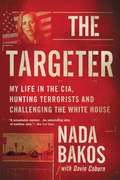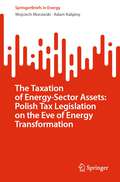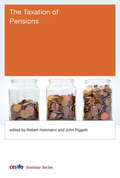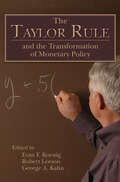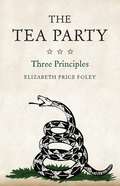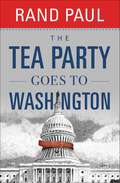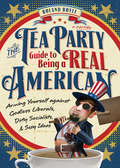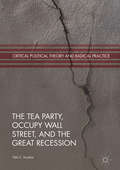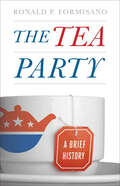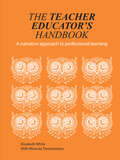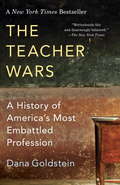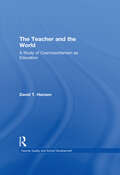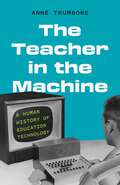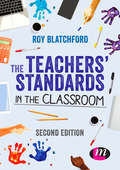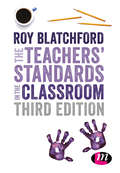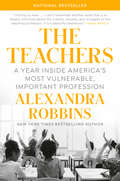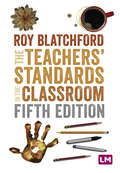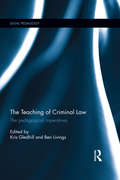- Table View
- List View
The Targeter: My Life in the CIA, Hunting Terrorists and Challenging the White House
by Nada BakosA revealing and utterly engrossing account" (Joby Warrick) of the world of high-stakes foreign intelligence and her role within the campaign to stop top-tier targets inside Al-Qaida from former CIA analyst Nada Bakos In 1999, 30-year-old Nada Bakos moved from her lifelong home in Montana to Washington, DC, to join the CIA. Quickly realizing her affinity for intelligence work, Nada was determined to rise through the ranks of the agency first as an analyst and then as a Targeting Officer, eventually finding herself on the frontline of America's War against Islamic extremists. In this role, Nada was charged with determining if Iraq had a relationship with 9/11 and Al-Qaida, and finding the mastermind behind this terrorist activity: Abu Musab al-Zarqawi. Her team's analysis stood the test of time, but it was not satisfactory for some members of the Administration.In a tight, tension-packed narrative that takes the reader from Langley deep into Iraq, Bakos reveals the inner workings of the Agency and the largely hidden world of intelligence gathering post 9/11. Entrenched in the world of the CIA, Bakos, along with her colleagues, focused on leading U.S. Special Operations Forces to the doorstep of one of the world's most wanted terrorists. Filled with on-the-ground insights and poignant personal anecdotes, The Targeter shows us the great personal sacrifice that comes with intelligence work. This is Nada's story, but it is also an intimate chronicle of how a group of determined, ambitious men and women worked tirelessly in the heart of the CIA to ensure our nation's safety at home and abroad.
The Taxation of Energy-Sector Assets: Polish Tax Legislation on the Eve of Energy Transformation (SpringerBriefs in Energy)
by Wojciech Morawski Adam KałążnyThis book answers the question: is Polish property tax legislation ready for the upcoming energy transformation?In Poland, real estate tax (property tax) is a material cost for property owners in energy because of the high value assets used by the sector. At the same time, unclear provisions of Polish tax law and variable jurisprudence can make it challenging for entrepreneurs to predict their tax bills. The current provisions of Polish tax law are often not well adjusted to the reality of modern economy, particularly in the case of assets used in the renewable energy sector. The book describes the problems that face taxpayers, tax authorities, and the administrative courts trying to apply current real estate tax provisions to renewable energy assets. The authors also examine the question of whether Polish legislators treat traditional and renewable sources of energy fairly.The readers of this book will be practitioners and researchers who are interested in issues of renewable energy taxation.
The Taxation of Pensions (CESifo Seminar Series)
by Robert HolzmannTheoretical and policy perspectives on the taxation of pension, viewed in an international context.Policy makers and academic researchers have been preoccupied in recent decades with the design of pension schemes and effective pension system reform. Relatively little attention has been given to the taxation of pensions and, more broadly, the provision of retirement income. In this book, experts from a range of countries explore the interconnection. Their contributions are especially timely, given recent demographic and political developments including population aging that lengthens the time between contribution payment and benefit receipt, the mobility of capital and labor brought about by globalization, and the complexity of pension taxation within and between countries. In shedding light on these issues, the chapters document the various forms of taxation of pension systems; use economic theory to explain both qualitative and quantitative observations; and consider whether the observed interaction of taxation and pensions is efficient. Theoretical overviews are followed by rigorous analyses of pension taxation in specific countries, including Denmark, Sweden, Portugal, Australia, Germany, the United Kingdom, and the United States.Contributors Torben M. Andersen, Spencer Bastani, Hazel Bateman, Sören Blomquist, Axel Börsch-Supan, Jorge Miguel Bravo, Gary Burtless, Rafal Chomik, Helmuth Cremer, Carl Emmerson, Csaba Feher, Bernd Genser, Robert Holzmann, Paul Johnson, Alain Jousten, Christian Keuschnigg, Eric Koepcke, George Kudrna, Jukka Lassila, Luca Micheletto, Pierre Pestieau, John Piggott, Christopher Quinn, Tarmo Valkonen, Alan Woodland
The Taylor Rule and the Transformation of Monetary Policy
by Robert Leeson Evan F. Koenig George A. KahnA contributors' "who's who" from the academic and policy communities explain and provide perspectives on John Taylor's revolutionary thinking about monetary policy. They explore some of the literature that Taylor inspired and help us understand how the new ways of thinking that he pioneered have influenced actual policy here and abroad.
The Tea Party
by Elizabeth Price FoleyIn The Tea Party: Three Principles, constitutional law professor Elizabeth Price Foley takes on the mainstream media's characterization of the American Tea Party movement, asserting that it has been distorted in a way that prevents meaningful political dialogue and may even be dangerous for America's future. Foley sees the Tea Party as a movement of principles over politics. She identifies three 'core principles' of American constitutional law that bind the decentralized, wide-ranging movement: limited government, unapologetic US sovereignty and constitutional originalism. These three principles, Foley explains, both define the Tea Party movement and predict its effect on the American political landscape. Foley explains the three principles' significance to the American founding and constitutional structure. She then connects the principles to current issues such as health care reform, illegal immigration, the war on terror, and internationalism.
The Tea Party Explained: From Crisis to Crusade
by Roman Skaskiw Yuri MaltsevThe Tea Party showed its strength in the 2010 mid-terms. Despite the opposition of leading Republicans like Dick Cheney, Karl Rove, and Lindsey Graham, 140 Tea Party candidates ran for Congress.<P><P> Of the sixty House seats which moved from Democratic to Republican control, twenty-eight were won by Tea Party candidates. At the movement's height, 29 percent of Americans had "some ties" to the Tea Party, while 2 percent identified themselves as active members.The Tea Party first attracted the media spotlight with Rick Santelli's televised rant against the government's bailout of mortgage borrowers on February 19, 2009, which instantly went viral as a video. As the authors document, however, "tea parties" associated with the Ron Paul movement had already been gathering momentum for more than a year.Beginning as a protest against government spending sprees and ballooning deficits, the Tea Party's sudden fame forced it to define itself on many issues where the membership was seriously divided. The Tea Party is a coalition of different outlooks, united only by belief in small, debt-free government and low taxes. Fiscal conservatives, who were usually liberal on social issues and against American military interventions, battled social conservatives, in an uneasy series of maneuvers which continues unresolved and is described in the book. The Tea Party Explained, written by two Tea Party activists who know the movement inside and out, is aimed at the intrigued and curious reader who wants to find out more about this unique phenomenon. The book gives a well-documented account of the Tea Party, its origins, its evolution, the bitter squabbles over its direction, its amazing successes in 2010, and its electoral rebuff in 2012. Maltsev and Skaskiw analyze the demographics of the Tea Party, the many organizations which have tried to represent, appropriate, or infiltrate the movement, and the ideological divisions in its ranks. The authors evaluate the strengths and weaknesses of the Tea Party and its likely future impact. A movement with strong local roots in many cities, firmly supported by a quarter of the US population, will not evaporate after one big defeat, and can be counted on to influence events for decades to come.
The Tea Party Goes to Washington
by Rand PaulIf the midterm elections were a declaration of war on the status quo, Rand Paul leads the battle charge. Voters fearful of growing government and debt have found voice in the Tea Party phenomenon and the movement continues to deliver a message that Washington, D.C. has found impossible to ignore.In THE TEA PARTY GOES TO WASHINGTON, the newly elected senator and self-described "constitutional conservative" explains why his party has to stand by its limited government rhetoric and why the federal government must be stuffed back into its constitutional box. Given the problems our nation faces, these are not mere suggestions, but moral imperatives.Rand Paul and those who voted for him want to stop borrowing, end the bailouts, and entitlements and the spending. In THE TEA PARTY GOES TO WASHINGTON you'll learn:The history of the Tea Party and why it isn't "extreme" How both parties operate outside the Constitution Rand's plan for a balanced budget Why the Tea Party will endureNow is the time to get America back on track-- this is the moment of the new revolution that will take us back to our grass roots, to the country of our founding fathers.It's a new day in Washington-- as the Tea Party graduates from populist outrage to political influence, Rand Paul stands poised to become one of its greatest champions.
The Tea Party Guide to Being a Real American
by Roland BoyleThis book is on your side. It's not like all the others. Other books are out to get you. You know the ones: Novels that crush your spirit. Celebrity bios that make your life look boring. Sexy books with filthy sex in them. This book, like America, has the answers. Good thing, too, because we are now faced with the most important question ever in the history of mankind. How can we tell who the real Americans are? Now, you may be thinking, "If you have to ask, you're not one, son." And that's a good start. But what we need is a simple answer. Complicated answers are for liars. The truth is as dumb as a box of hammers.
The Tea Party, Occupy Wall Street, and the Great Recession: Protest As Symptoms (Critical Political Theory and Radical Practice)
by Nils C. KumkarThis book analyzes the Tea Party and Occupy Wall Street as symptoms of the structural crisis of US capitalism and its class structure. It shows that the protests have to be understood as rooted in the petty bourgeoisie’s lived experience of crisis, which also plays a crucial role in current political developments like the successful presidential campaign of Donald Trump. The book explains the Great Recession as an acute phase of the structural crisis of the finance-dominated accumulation regime, identifies the social classes from which the core-participants of the respective protests recruited themselves and the socioeconomic developments to which they were exposed in the years leading up to the protests, and interprets interviews and group discussions conducted with activists to reconstruct the habitus that structured both their experience of the crisis and their resonance with the respective protest practices. It thereby provides an encompassing understanding of the social logics not only of these social movements, but of the current political conjuncture in the US.
The Tea Party: A Brief History
by Ronald P. FormisanoThe Tea Party burst on the national political scene in 2009–2010, powered by right-wing grassroots passion and Astroturf big money. Its effect on electoral politics and the political process is undeniable, but the message, aims, and staying power of the loosely organized groups seem less clear. In this concise book, American political historian Ronald P. Formisano probes the remarkable rise of the Tea Party movement during a time of economic crisis and cultural change and examines its powerful impact on American politics.A confederation of intersecting and overlapping organizations, with a strong connection to the Christian fundamentalist Right, the phenomenon could easily be called the Tea Parties. The American media’s fascination with the Tea Party—and the tendency of political leaders who have embraced the movement to say and do outlandish things—not only has fueled the fire driving the movement, but has diverted attention from its roots, agenda, and the enormous influence it holds over the Republican Party and the American political agenda. Looking at the Tea Party's claims to historical precedent and patriotic values, Formisano locates its anti-state and libertarian impulses deep in American political culture as well as in voter frustrations that have boiled over in recent decades. He sorts through the disparate goals the movement’s different factions espouse and shows that, ultimately, the contradictions of Tea Party libertarianism reflect those ingrained in the broad mass of the electorate.Throughout American history, third parties, pressure groups, and social movements have emerged to demand reforms or radical change, only to eventually fade away, even if parts of their programs often are later adopted. The Tea Party’s impact as a pressure group has been more immediate. Whether the Tea Party endures remains to be seen. Formisano’s brief history certainly gives us clues.
The Tea Party: A Brief History
by Ronald P. FormisanoA historian looks at the remarkable rise of the Tea Party movement and its effect on American politics.The Tea Party burst on the national political scene in 2009–2010, powered by right-wing grassroots passion and Astroturf big money. Its effect is undeniable, but the message, aims, and staying power of the loosely organized groups seem unclear. In this book, American political historian Ronald P. Formisano probes the rise of the Tea Party movement during a time of economic crisis and cultural change and examines its impact on American politics.A confederation of intersecting and overlapping organizations, with a strong connection to the Christian fundamentalist Right, the phenomenon could easily be called the Tea Parties. The American media’s fascination with the Tea Party?and the tendency of political leaders embracing the movement to say and do outlandish things?not only helped the movement, but also has diverted attention from its roots, agenda, and the influence it holds over the Republican Party and the American political agenda. Looking at the Tea Party’s claims to historical precedent and patriotic values, Formisano locates its anti-state and libertarian impulses deep in American political culture as well as in recent voter frustrations. He sorts through the goals the movement’s different factions espouse and shows that, ultimately, the contradictions of Tea Party libertarianism reflect those ingrained in the broad mass of the electorate.Throughout American history, movements have emerged to demand reforms or radical change, only to eventually fade away, even if parts of their programs often are later adopted. Whether the Tea Party endures remains to be seen, but Formisano’s brief history certainly offers clues.
The Teacher Educator's Handbook: A narrative approach to professional learning (Critical Guides for Teacher Educators)
by Elizabeth WhiteProfessional learning and development for all teacher educators through stories of practice and carefully structured coaching questions.This book provides all teacher educators, wherever they are based, with key opportunities for professional learning and development, especially in relation to the new initial teacher education (ITE) core content framework and the new early career framework. A range of detailed narratives about practice have been written by teacher educators, for teacher educators, and are carefully curated by the author to draw out key learning points, including a range of coaching questions. Of interest for individuals and groups of teacher educators, and especially those working in partnerships, the book also contains research- and practice-informed guidance that can be used in professional development sessions.
The Teacher Insurgency: A Strategic and Organizing Perspective (Education Politics and Policy)
by Leo CaseyIn The Teacher Insurgency, Leo Casey addresses how the unexpected wave of recent teacher strikes has had a dramatic impact on American public education, teacher unions, and the larger labor movement. Casey explains how this uprising was not only born out of opposition to government policies that underfunded public schools and deprofessionalized teaching, but was also rooted in deep-seated changes in the economic climate, social movements, and, most importantly, educational politics. With an eye to maintaining the momentum of the insurgency, the author examines four key strategic questions that have arisen from the strikes: the relationship of mobilization to organizing; the relationship between protests and direct action; the conditions under which teacher strikes are most likely to be successful; and the importance of &“bargaining for the common good.&” More broadly, Casey examines how to organize teachers for collective action, focusing on four discourses of teaching: teaching as nurturance; as professionalism; as labor and craft; and as a vocation of democratic intellectual work.
The Teacher Wars: A History of America's Most Embattled Profession
by Dana GoldsteinIn her groundbreaking history of 175 years of American education, Dana Goldstein finds answers in the past to the controversies that plague our public schools today.Teaching is a wildly contentious profession in America, one attacked and admired in equal measure. In The Teacher Wars, a rich, lively, and unprecedented history of public school teaching, Dana Goldstein reveals that teachers have been similarly embattled for nearly two centuries. From the genteel founding of the common schools movement in the nineteenth century to the violent inner-city teacher strikes of the 1960s and '70s, from the dispatching of Northeastern women to frontier schoolhouses to the founding of Teach for America on the Princeton University campus in 1989, Goldstein shows that the same issues have continued to bedevil us: Who should teach? What should be taught? Who should be held accountable for how our children learn? She uncovers the surprising roots of hot button issues, from teacher tenure to charter schools, and finds that recent popular ideas to improve schools—instituting merit pay, evaluating teachers by student test scores, ranking and firing veteran teachers, and recruiting &“elite&” graduates to teach—are all approaches that have been tried in the past without producing widespread change. And she also discovers an emerging effort that stands a real chance of transforming our schools for the better: drawing on the best practices of the three million public school teachers we already have in order to improve learning throughout our nation&’s classrooms. The Teacher Wars upends the conversation about American education by bringing the lessons of history to bear on the dilemmas we confront today. By asking &“How did we get here?&” Dana Goldstein brilliantly illuminates the path forward.
The Teacher and the World: A Study of Cosmopolitanism as Education (Teacher Quality and School Development)
by David T. HansenWinner of the 2013 American Educational Studies Association's 2013 Critics Choice Award! Teachers the world over are seeking creative ways to respond to the problems and possibilities generated by globalization. Many of them work with children and youth from increasingly varied backgrounds, with diverse needs and capabilities. Others work with homogeneous populations and yet are aware that their students will encounter many cultural changes in their lifetimes. All struggle with the contemporary conditions of teaching: endless top-down measures to manipulate what they do, rapid economic turns and inequality in supportive resources that affect their lives and those of their students, a torrent of media stimuli that distract educational focus, and growth as well as shifts in population. In The Teacher and the World, David T. Hansen provides teachers with a way to reconstruct their philosophies of education in light of these conditions. He describes an orientation toward education that can help them to address both the challenges and opportunities thrown their way by a globalized world. Hansen builds his approach around cosmopolitanism, an ancient idea with an ever-present and ever-beautiful meaning for educators. The idea pivots around educating for what the author calls reflective openness to new people and new ideas, and reflective loyalty toward local values, interests, and commitments. The book shows how this orientation applies to teachers at all levels of the system, from primary through university. Hansen deploys many examples to illustrate how its core value, a balance of reflective openness to the new and reflective loyalty to the known, can be cultivated while teaching different subjects in different kinds of settings. The author draws widely on the work of educators, scholars in the humanities and social sciences, novelists, artists, travellers and others from both the present and past, as well as from around the world. These diverse figures illuminate the promise in a cosmopolitan outlook on education in our time. In this pioneering book, Hansen has provided teachers, heads of school, teacher educators, researchers, and policy-makers a generative way to respond creatively to the pressure and the promise of a globalizing world.
The Teacher in the Machine: A Human History of Education Technology
by Anne TrumboreThe surprising history of education technology and its political, financial, and social impact on higher education and our worldFrom AI tutors who ensure individualized instruction but cannot do math to free online courses from elite universities that were supposed to democratize higher education, claims that technological innovations will transform education often fall short. Yet, as Anne Trumbore shows in The Teacher in the Machine, the promises of today&’s cutting-edge technologies aren&’t new. Long before the excitement about the disruptive potential of generative AI–powered tutors and massive open online courses, scholars at Stanford, MIT, and the University of Illinois in the 1960s and 1970s were encouraged by the US government to experiment with computers and artificial intelligence in education. Trumbore argues that the contrast between these two eras of educational technology reveals the changing role of higher education in the United States as it shifted from a public good to a private investment.Writing from a unique insider&’s perspective and drawing on interviews with key figures, historical research, and case studies, Trumbore traces today&’s disparate discussions about generative AI, student loan debt, and declining social trust in higher education back to their common origins at a handful of elite universities fifty years ago. Arguing that those early educational experiments have resonance today, Trumbore points the way to a more equitable and collaborative pedagogical future. Her account offers a critical lens on the history of technology in education just as universities and students seek a stronger hand in shaping the future of their institutions.
The Teachers' Standards in the Classroom
by Roy BlatchfordAll teachers and trainee teachers must work towards and within the framework of the Teachers' Standards. This book is the essential guide to the application of these standards in the classroom. The text supports you to interpret the standards effectively and independently, and to apply them to your teaching. The chapters mirror the standards themselves and practical guidance and classroom-based examples help link theory to practice. The text also enables you to enhance your understanding of the standards and improve your teaching and professional practice. This second edition has been updated to include notes on the new OFSTED framework and the new National Curriculum. Also included are more questions to help trainee teachers think around the standards in relation to placements and assess how and whether they have met the requirements.
The Teachers' Standards in the Classroom (Achieving Qts Ser.)
by Roy BlatchfordAll teachers and trainee teachers need to work towards and within the framework of the Teachers' Standards. This is the essential guide to the application of these standards in the classroom. The text is written to support teachers and trainee teachers to interpret the standards effectively and independently, and to apply them to their teaching. The chapters mirror the standards themselves and practical guidance and classroom based examples help the reader link theory to practice. The text supports readers to enhance their understanding of the standards and to see how their effective application can improve teaching and professional practice. This third edition has been updated to include more classroom stories, links to practice and examples of good practice. Also included is guidance on contemporary issues in relation to the standards, to support teachers with current challenges.
The Teachers' Standards in the Classroom (Ready to Teach)
by Roy BlatchfordAll teachers and trainee teachers need to work towards and within the framework of the Teachers' Standards. This is the essential guide to the application of these standards in the classroom. The text is written to support teachers and trainee teachers to interpret the standards effectively and independently, and to apply them to their teaching. The text supports readers to enhance their understanding of the standards and to see how their effective application can improve teaching and professional practice. This fourth edition has been updated to include checklist for all standards. Also added is guidance on personal and professional conduct online for new teachers. New content on the 2019 Ofsted framework'e expectations of teaching is also added in this edition. About the author Roy Blatchford CBE is Founding Director of the National Education Trust in the UK. He served as one of Her Majesty&’s Inspectors of Schools (HMI) in England, with national responsibilities for school improvement and for the inspection of outstanding schools. Roy was Deputy Chair of the DfE Teachers&’ Standards Review (2012) and of the Headteachers&’ Standards Review (2014). He was appointed CBE for services to education in the 2016 New Year Honours.
The Teachers' Standards in the Classroom (Ready to Teach)
by Roy BlatchfordAll teachers and trainee teachers need to work towards and within the framework of the Teachers' Standards. This is the essential guide to the application of these standards in the classroom. The text is written to support teachers and trainee teachers to interpret the standards effectively and independently, and to apply them to their teaching. The text supports readers to enhance their understanding of the standards and to see how their effective application can improve teaching and professional practice. This fourth edition has been updated to include checklist for all standards. Also added is guidance on personal and professional conduct online for new teachers. New content on the 2019 Ofsted framework'e expectations of teaching is also added in this edition. About the author Roy Blatchford CBE is Founding Director of the National Education Trust in the UK. He served as one of Her Majesty&’s Inspectors of Schools (HMI) in England, with national responsibilities for school improvement and for the inspection of outstanding schools. Roy was Deputy Chair of the DfE Teachers&’ Standards Review (2012) and of the Headteachers&’ Standards Review (2014). He was appointed CBE for services to education in the 2016 New Year Honours.
The Teachers: A Year Inside America's Most Vulnerable, Important Profession
by Alexandra RobbinsA riveting, must-read, year-in-the-life account of three teachers, combined with reporting that reveals what&’s really going on behind school doors, by New York Times bestselling author and education expert Alexandra Robbins. Alexandra Robbins goes behind the scenes to tell the true, sometimes shocking, always inspirational stories of three teachers as they navigate a year in the classroom. She follows Penny, a southern middle school math teacher who grappled with a toxic staff clique at the big school in a small town; Miguel, a special ed teacher in the western United States who fought for his students both as an educator and as an activist; and Rebecca, an East Coast elementary school teacher who struggled to schedule and define a life outside of school. Robbins also interviewed hundreds of other teachers nationwide who share their secrets, dramas, and joys. Interspersed among the teachers&’ stories—a seeming scandal, a fourth-grade whodunit, and teacher confessions—are hard-hitting essays featuring cutting-edge reporting on the biggest issues facing teachers today, such as school violence; outrageous parent behavior; inadequate support, staffing, and resources coupled with unrealistic mounting demands; the &“myth&” of teacher burnout; the COVID-19 pandemic; and ways all of us can help the professionals who are central both to the lives of our children and the heart of our communities.
The Teachers′ Standards in the Classroom (Ready to Teach)
by Roy BlatchfordAll teachers and trainee teachers need to work towards and within the framework of the Teachers′ Standards. This is the essential guide to the application of these standards in the classroom. *Supports teachers and trainee teachers to interpret the standards effectively and independently. *Demontrates how the standards relate to the classroom. *Practical guidance and classroom based examples linking theory to practice. *Enables readers to enhance their understanding of the standards and to see how their effective application can improve teaching and professional practice. This fifth edition edition has been updated to include a visualisation of each standard. Also added is content on the Core Content Framework (CCF) for Initial Teacher Training and the Early Career Framework (ECF).
The Teachers′ Standards in the Classroom (Ready to Teach)
by Roy BlatchfordAll teachers and trainee teachers need to work towards and within the framework of the Teachers′ Standards. This is the essential guide to the application of these standards in the classroom. *Supports teachers and trainee teachers to interpret the standards effectively and independently. *Demontrates how the standards relate to the classroom. *Practical guidance and classroom based examples linking theory to practice. *Enables readers to enhance their understanding of the standards and to see how their effective application can improve teaching and professional practice. This fifth edition edition has been updated to include a visualisation of each standard. Also added is content on the Core Content Framework (CCF) for Initial Teacher Training and the Early Career Framework (ECF).
The Teaching of Criminal Law: The pedagogical imperatives (Legal Pedagogy)
by Kris Gledhill Ben LivingsThe Teaching of Criminal Law provides the first considered discussion of the pedagogy that should inform the teaching of criminal law. It originates from a survey of criminal law courses in different parts of the English-speaking world which showed significant similarity across countries and over time. It also showed that many aspects of substantive law are neglected. This prompted the question of whether any real consideration had been given to criminal law course design. This book seeks to provide a critical mass of thought on how to secure an understanding of substantive criminal law, by examining the course content that best illustrates the thought process of a criminal lawyer, by presenting innovative approaches for securing active learning by students, and by demonstrating how criminal law can secure other worthwhile graduate attributes by introducing wider contexts. This edited collection brings together contributions from academic teachers of criminal law from Australia, New Zealand, the United Kingdom, and Ireland who have considered issues of course design and often implemented them. Together, they examine several innovative approaches to the teaching of criminal law that have been adopted in a number of law schools around the world, both in teaching methodology and substantive content. The authors offer numerous suggestions for the design of a criminal law course that will ensure students gain useful insights into criminal law and its role in society. This book helps fill the gap in research into criminal law pedagogy and demonstrates that there are alternative ways of delivering this core part of the law degree. As such, this book will be of key interest to researchers, academics and lecturers in the fields of criminal law, pedagogy and teaching methods.
The Teaching of Criminal Law: The pedagogical imperatives (Legal Pedagogy)
by Kris Gledhill Ben LivingsThe Teaching of Criminal Law provides the first considered discussion of the pedagogy that should inform the teaching of criminal law. It originates from a survey of criminal law courses in different parts of the English-speaking world which showed significant similarity across countries and over time. It also showed that many aspects of substantive law are neglected. This prompted the question of whether any real consideration had been given to criminal law course design. This book seeks to provide a critical mass of thought on how to secure an understanding of substantive criminal law, by examining the course content that best illustrates the thought process of a criminal lawyer, by presenting innovative approaches for securing active learning by students, and by demonstrating how criminal law can secure other worthwhile graduate attributes by introducing wider contexts. This edited collection brings together contributions from academic teachers of criminal law from Australia, New Zealand, the United Kingdom, and Ireland who have considered issues of course design and often implemented them. Together, they examine several innovative approaches to the teaching of criminal law that have been adopted in a number of law schools around the world, both in teaching methodology and substantive content. The authors offer numerous suggestions for the design of a criminal law course that will ensure students gain useful insights into criminal law and its role in society.This book helps fill the gap in research into criminal law pedagogy and demonstrates that there are alternative ways of delivering this core part of the law degree. As such, this book will be of key interest to researchers, academics and lecturers in the fields of criminal law, pedagogy and teaching methods.
